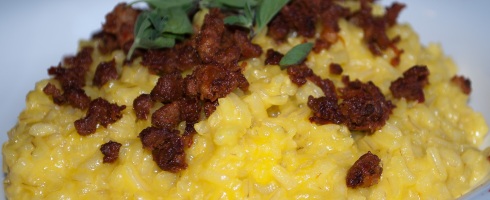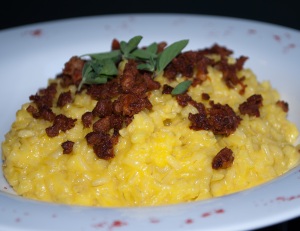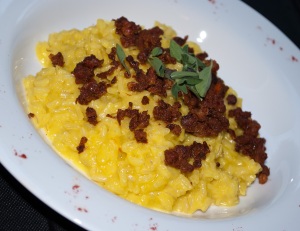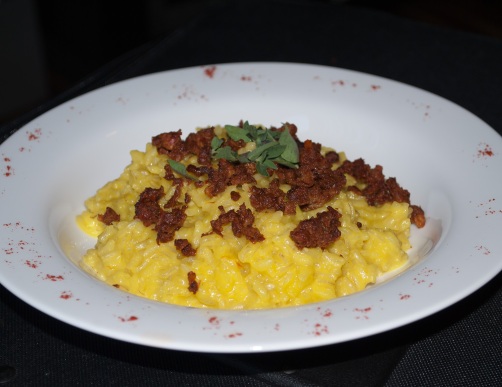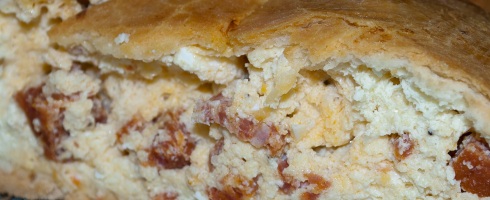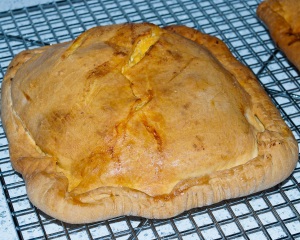It’s the Final Round of the Marx Foods Integrale Gauntlet! My final entry not only fuses the great Italian Integrale rice with some of the flavors of Mexico, but I also have found a way to add the cuisine of another of my favorite countries, Japan! Yes, that’s right folks, I present to you Mexican Sushi made with Italian Integrale rice! I really wanted to show everyone the versatility of this great product, and I think with the three entries I have made for the Integrale Gauntlet, from a risotto, to a rice pudding, and now sushi, I have really given this Italian short grain
One may ask the question, What is Mexican Sushi? Well, it is not much different from the classic Japanese sushi that we all know and love. It just simply utilizes some Mexican flavors to kick up the volume. We replace the wasabi placed under the nigiri (a slice of raw fish on a thumb sized chunk of rice) with chipotle, add in a little jalapeno in our futomaki ( or “fat” roll) , some ripe avocado, toss in a little cilantro and we have our Mexican Sushi!
One of the challenges of making this dish was trying to get the Integrale rice to play the role of the classic Japanese sushi rice. I found that you need to tweek two parts in the process. I found that you needed to soak the rice for a extended period of time before cooking. I also needed to decrease the amount of water used in the preparation of the rice or else the rice becomes too much like dough.
Once I had cooked and seasoned my rice, I wanted to make two different types of rolls for my entry. I wanted to make the classic Futomaki, a seaweed encased sushi roll filled with cucumber, carrot, jalepeño, and a hint of my chipotle mayo. I call this the “Chilango” roll, a complete vegan roll inspired by the chic urban youth of Mexico City. Next on my list was the “Mexicali’ roll. This is a Uramaki, or an inside-out roll. This type of roll is a bit more challenging because you have to flip the nori (the seaweed) over once the rice is spread out. For this roll I wanted to meld the flavors of smoked salmon, green onion, cream cheese, cilantro, and finally some avocado. Now there was one more roll I wanted to make, but my rice supply was dwindling, so I set to making the Nigiri.
This is a fairly simple preparation that involves making a thumb-sized oblong portion of rice and slapping a piece of raw fish on top. I wanted to kick it up a bit and I slathered my chipotle mayo over the bottom side of the fish and then placed it on the rice. I had a beautiful portion of sushi-grade Ahi tuna, some smoked salmon (smoked locally in Maine of course!) , and some fresh jumbo shrimp.
So here we are, two plates of delicious Italian-Mexican-Japanese inspired sushi! Grab an Asahi or some Saki and Kanpai!!!
Integrale Sushi Rice
- 1 cup of Integrale Rice
- 1/2 cup of rice vinegar
- 1/2 tsp kosher salt
- 1/2 tsp organic sugar
- 2 cups of water
- Place the rice in a large glass bowl and rinse the rice with cold water for 10 minutes or until the water become clear and no longer cloudy. You are rinsing all the starch from rice.
- Soak the rice in cold water for at least 1 hour.
- Dump the rice into a fine mesh sieve and allow to drain for at least 30 minutes.
- Place into a rice cooker and add the 2 cups of water.
- Set cooker to Cook and let it go!
- Once the switch resets to warm, allow the rice to steam for about 15 minutes.
- Remove the rice, using a wooden spoon, to a non-reactive bowl to season the rice.
- Place the rice vinegar, salt, and sugar in a cup and put in microwave for 15 seconds. We just want to dissolve the salt and sugar to make a solution.
- Now season the rice with vinegar solution.
- Allow the rice to cool to room temperature.
Chilango Roll
- 3/4 cup sushi rice.
- 1 nori sheets
- Carrot
- Cucumber
- Jalepeno
- Chipotle Mayo
- Take a nori sheet. Place it on the mat, with the shiny side facing down.
- Grab a handful of prepared sushi rice, and spread it gently over the nori – about 1cm high. There’s no need to press the rice onto the nori, only spread it.
- Line up the cucumber, carrot, jalepeño on the roll.
- Spread a bit of the chipotle mayo on the vegetables.
- Roll.
- Cut into 8 equal pieces. For best results first cut in half, then cut each half into two, and then again.
- Best served with soy sauce, pickled ginger (gari) and wasabi.
Mexicali Roll
- 3/4 cup sushi rice.
- 1 nori sheets
- Smoked Salmon
- Green Onion
- Avocado
- Cream Cheese
- Cilantro
- Black and white sesame seeds
- Wrap your bamboo mat with plastic wrap. This is necessary in order to prevent rice from sticking to the mat.
- Take a nori sheet, and break it in half. Place one half on the mat, with the shiny side facing down.
- Grab a handful of prepared sushi rice, and spread it gently over the nori – about 1cm high. There’s no need to press the rice onto the nori, only spread it.
- Sprinkle a spoonful of black and white sesame seeds evenly over the rice.
- Flip the nori so that the rice is now facing down.
- Line up the green onion, smoked salmon, avocado, cilantro and some cream cheese on the roll.
- Roll.
- Cut into 8 equal pieces. For best results first cut in half, then cut each half into two, and then again.






